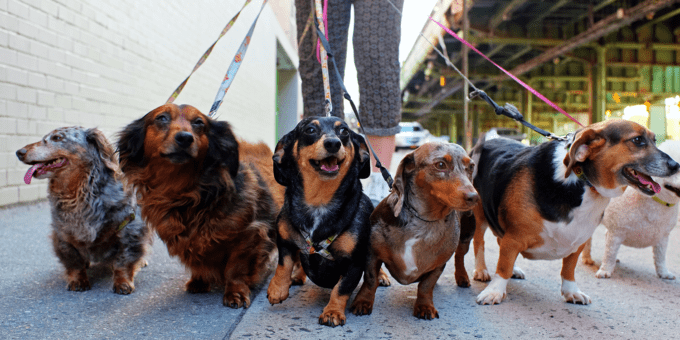Bored of the daily 9-5 office grind? Tired of being cooped up between four walls? Finding yourself distracted by cute dog videos on Twitter, wishing you could be out there in the fresh air with them? Then wish no more – Rapid Formations is here to “walk” you through the essentials of starting a dog-walking business!
1. Set up a company
So first things first, you’ll need to register your company at Companies House using a reliable company formation agent – we’d recommend ourselves, obviously! If you’ve never incorporated a company before, don’t worry. It’s quick and easy and we can have you registered and trading in a matter of hours. Just pick your company name, choose your package, and let us do the rest!
2. Get insured
When setting up any type of business, you must have appropriate and adequate business Insurance. As you are providing a service, you’ll need at the very least to be covered by Public Liability Insurance (PLI) in case your dogs cause damage or injury while under your supervision. You can check out what options are available using a well-known comparison website such as Compare The Market or Go Compare.
You may also want to consider other kinds of insurance, such as Care Custody and Control insurance which will cover you in case a dog is injured or lost due to your negligence, or Non-Negligent Cover in case of accidental injury to a dog in your care.
Many insurers offer specialised packages for multiple aspects of dog walking businesses, so you may also want to check out your options for all-inclusive cover as well.
3. Check your licences
Check with your local council whether they require you to have any specific licences in order to operate as a dog walker in local parks. Requirements may vary between local authorities so make sure you get the right info. Type in your postcode here to find your local council website.
4. Brush up on your bookkeeping
Like any self-employed business, you will need to make sure that you are paying the correct amount of tax when you file your Self Assessment tax return at the end of each financial year.
The amount of tax you are liable to pay will depend on how much profit you make, so you will need to make sure that you are keeping an accurate record of all your income and expenditure, including all receipts for the latter as HMRC may request to view these.
And don’t forget that legitimate expenses are tax deductible, so you will want to ensure that you record everything you spend.
For more information on your tax liabilities and how to go about submitting your Self Assessment tax return, check out this helpful accounting blog by All About Accountants.
5. Consider your services
Now that you’ve got the formalities out of the way, it’s time to start thinking about how you plan to run your business. You will probably want to charge in time blocks (15 minutes, 30 minutes, etc) but you may also consider different pricing structures depending on whether you plan to walk single dogs, or multiple dogs at a time.
You may also want to think about offering other related services such as dog-sitting. Local competition will likely dictate your final pricing, so you will want to do a bit of research on the local competition as well when considering this.
6. Spread the word
You can be as prepared as a boy scout, but if nobody knows you’re offering these services then your business isn’t going to get very far. So it’s imperative you put some work into advertising and promoting your business.
Social media is a great way to do this, and popular platforms like Facebook will allow you to create your own Business Page where you can advertise your services and make contact with potential clients to discuss their needs and requirements.
Remember, though, that it is always better to meet customers and their pooches in person before coming to any final agreement.
There is also still lots to be said for more traditional means of advertising. There is a whole demographic out there, in particular older generations, who may not be as tech savvy as their younger relatives, but who could still be a vital source of clientele for you. So good old-fashioned door-to-door leafleting in areas you identify as having a lot of four-legged residents can also provide good returns.
7. Draw up a contract
Once you begin to receive interest in your business, make sure that you have your clients sign a contract detailing exactly what is expected of both parties. This will include what services are expected of you and at what price, and should also make clear who is responsible for things like veterinary trips and expenses.
Other things to consider when starting a dog-walking business
If you follow all of the above, you should be well on your way to starting a dog-walking business, but there is always more you can do to improve your business’ chances of flourishing.
For example, while by no means essential, gaining prior experience of dog handling could be very helpful before you begin providing such a service professionally. You could try calling local kennels or RSPCA centre to see if they have any voluntary work available with their dogs to help get you used to handling dogs of different sizes, natures and behaviour.
You could also consider gaining a professional qualification in an area such as dog training or medication. Not only will this provide you with useful skills, but it will also look much more impressive to potential clients who want to feel confident in those who are taking charge of their precious pooches.
Similarly, you may want to consider joining the National Association of Pet Sitters and Dog Walkers (NARPS) who are a registered trade association which provide useful help and advice to individuals and businesses in the pet industry. This includes covering many of the points mentioned in this article such as insurance and contracts, and also offers a forum where members can chat and share real-life advice and experiences.
Any questions?
Hopefully The Rapid guide to starting a dog-walking business will have answered most of your questions about how to get your new canine venture up and running, but you can always get in touch if you have further queries. You can follow us on Twitter using the @RapidUKOfficial handle and via our Facebook page.
Please note that the information provided in this article is for general informational purposes only and does not constitute legal, tax, or professional advice. While our aim is that the content is accurate and up to date, it should not be relied upon as a substitute for tailored advice from qualified professionals. We strongly recommend that you seek independent legal and tax advice specific to your circumstances before acting on any information contained in this article. We accept no responsibility or liability for any loss or damage that may result from your reliance on the information provided in this article. Use of the information contained in this article is entirely at your own risk.








Join The Discussion
Comments (1)
Thanks for explaining its importance through this well-detailed article.